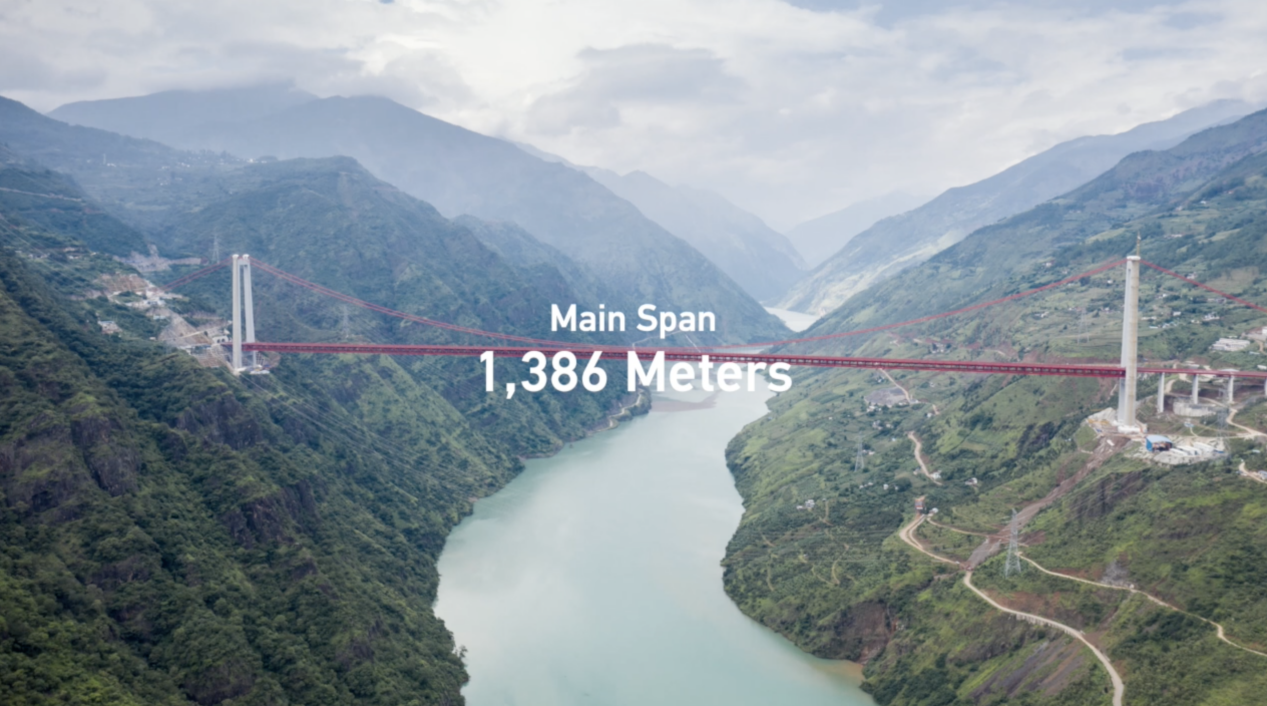04:58

The Jinsha River flows from the Tanggula Mountains on the Qinghai-Tibet Plateau over 5, 000 meters above sea level. It joins China's longest river – the Yangtze River. Along the Jinsha River and its beautiful scenery, villages rely on the agriculture industry. However, the mountainous terrain has made it a challenge for local villagers to travel outside the region. People used to drive on hilly roads that were subject to sudden rain storms or heavy winds.
Stretching for 1,386 meters, the Jin'an Jinsha River Bridge connects people from both sides of the valley in Lijiang City of southwest China's Yunnan Province. That was where I visited this time.
It used to take residents an hour to reach the other side of the valley. Now, with this mountain suspension bridge, the drive only takes a minute.

A picture of the Jin'an Jinsha River Bridge. /CGTN
A picture of the Jin'an Jinsha River Bridge. /CGTN
The bridge holds the world record for the longest mountain suspension bridge.
I was shaking while standing on top of the bridge tower – almost 500 meters above the Jinsha River. But witnessing how grand the bridge is was quite an experience. It has also helped change people's lives here.
"The main source of income for my village is growing fruits … like peaches. It used to take us two hours to send our fruits to bigger counties. Now, it only takes half an hour," said He Fulong.
He is from a nearby village of 800 people called Zengming. Local farmers there mainly grow fruits for sale. But a decade ago, it took days for local villagers to get their fruit out. For perishable agricultural products, time is everything. Locals were only making a few hundred bucks a year. With better roads and the bridge, their income has doubled over the past 10 years.
"The most important thing is transportation. Otherwise, it could be dangerous for you to take your goods out and people from outside would not come. Roads are key," said He while chewing on his fresh pomegranate.

The bridge holds the record for the world's longest mountain suspension bridge. /CGTN
The bridge holds the record for the world's longest mountain suspension bridge. /CGTN
The chief engineer for constructing the Jin'an Jinsha River Bridge just had knee surgery. So, I visited him at his home. He showed me all the photos he took of the bridge.
"When we hoist the steel beam, all the protective items below are ready. It is about 340 meters from the bottom of the steel beam at this position to the Jinsha River surface. When we drop a screw, we see nothing. We need to lay the steel beam in an almost flat position," said Zhang Ping, an engineer from China Communications Construction.
"When it's relatively stable, the height difference should not exceed 50 centimeters. If it exceeds 50 centimeters, there is a safety risk," Zhang added.
Construction of the bridge took three and a half years. A total of 40,000 tons of steel wires were used. These wires act like muscles for the bridge – holding it up. Zhang in fact grew up in the mountains, where the bridge is. He remembers the days when there were no roads or bridges.
"When we were young, we didn't have tractors in our village. There were only horse carriages to take us to the county. I can still remember riding horse carriages," Zhang added.
Bridges, better roads and improved traffic have been helping China to achieve its poverty alleviation goals.
It took China eight years to eliminate absolute poverty and the country is carefully engineering further plans to prevent people from returning to poverty.
In the past decade, China has constructed and fixed almost 100,000 kilometers of highways strengthening regional connectivity in poor areas.
More bridges like the Jin'an Jinsha River Bridge are being built in China – breaking world records.
They are not mere grand gestures of the country's engineering capability, but they are evidence of its determination to leave no one behind.